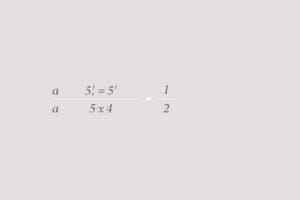Podcast
Questions and Answers
What is the left Riemann sum approximation for the volume of the tank?
What is the left Riemann sum approximation for the volume of the tank?
176.3 cubic feet
Does the approximation in Part A overestimate or underestimate the volume of the tank?
Does the approximation in Part A overestimate or underestimate the volume of the tank?
overestimate
What is the volume of the tank based on the model f(h) = 50.3/[e^(0.2h) + h]?
What is the volume of the tank based on the model f(h) = 50.3/[e^(0.2h) + h]?
101.325 cubic feet
What is the rate at which the volume of water is changing when the height is 5 feet?
What is the rate at which the volume of water is changing when the height is 5 feet?
What is the area of region R bounded by the curve r=f(θ) = 1 + sinθ cos(2θ) from 0 to π/2?
What is the area of region R bounded by the curve r=f(θ) = 1 + sinθ cos(2θ) from 0 to π/2?
Write an equation that would determine the value of k which divides the area of region S into two equal parts.
Write an equation that would determine the value of k which divides the area of region S into two equal parts.
What is the expression for w(θ), the distance between the points with polar coordinates (f(θ), θ) and (g(θ), θ)?
What is the expression for w(θ), the distance between the points with polar coordinates (f(θ), θ) and (g(θ), θ)?
What is the average value of w(θ) over the interval 0 ≤ θ ≤ π/2?
What is the average value of w(θ) over the interval 0 ≤ θ ≤ π/2?
Study Notes
Tank Volume and Area Calculations
- A tank with a height of 10 feet has a decreasing function A(h) for horizontal cross-section area at height h.
- Volume of the tank can be approximated using a left Riemann sum:
- Volume = ∫{0,10} A(h) dh
- Approximation: 2 * 50.3 + 3 * 14.4 + 5 * 6.5 = 176.3 cubic feet.
Overestimation of Volume
- Using a left Riemann sum results in an overestimate when A(h) is decreasing, as it captures the area at the left endpoint of each subinterval.
Exact Volume Using Model
- The area function is modeled as f(h) = 50.3/[e^(0.2h) + h].
- Volume calculated as ∫{0,10} f(h) dh = 101.325 cubic feet, demonstrating that the integral of area gives volume.
Rate of Volume Change
- When water is at a height of 5 feet, it rises at 0.26 feet per minute.
- Rate of volume change: dV/dt = (dV/dh) * (dh/dt) = f(5) * 0.26 = 1.694 cubic feet per minute.
Polar Area Calculations
- For polar curves r = f(θ) = 1 + sin(θ)cos(2θ) and r = g(θ) = 2cos(θ) over the interval [0, π/2]:
- Area of region R is found using the formula:
- Area = (1/2) ∫{0, π/2} (f(θ))² dθ = 0.648.
- Area of region R is found using the formula:
Equation for Equal Areas
- The ray θ = k divides region S into equal areas, leading to the equation:
- ∫{0,k} ((g(θ))² - (f(θ))²) dθ = (1/2) ∫{0, π/2} ((g(θ))² - (f(θ))²) dθ.
Distance Between Points in Polar Coordinates
- The distance w(θ) between points (f(θ), θ) and (g(θ), θ) is defined as:
- w(θ) = g(θ) - f(θ).
- Average value of w(θ) over [0, π/2]:
- w_A = [1/(π/2 - 0)] [∫{0, π/2} w(θ) dθ] = 0.485.
Finding Specific Value of θ
- Determining θ for which w(θ) = w_A requires solving the equation with respect to the average distance w_A found above.
Studying That Suits You
Use AI to generate personalized quizzes and flashcards to suit your learning preferences.
Description
Prepare for the AP BC Calculus exam with this quiz focused on the 2017 free response questions. This specific problem involves calculating the volume of a tank using a left Riemann sum, emphasizing integration and approximation techniques. Test your understanding of calculus concepts with this targeted review.




